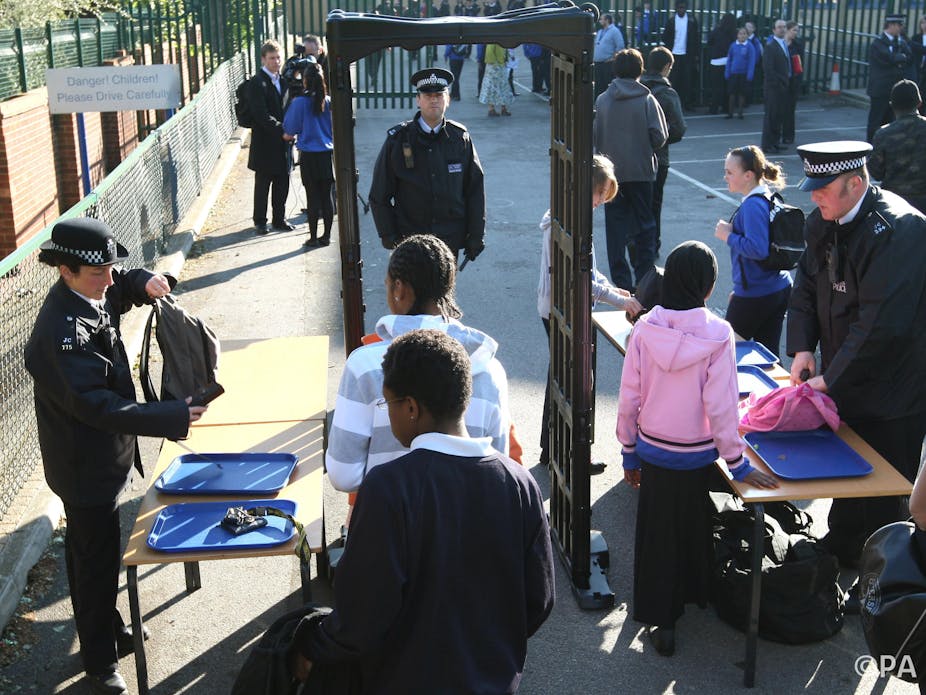The recent horrifying spectacle of a disturbed student fatally stabbing his teacher in front of his classmates in Leeds has spurred a national dialogue about how schools should address violence.
Perhaps the most controversial measure under consideration is expanding the use of knife arches – known in the US as walk-through metal detectors. Given metal detectors’ longevity in some US schools (since 1992 in Chicago’s high schools), the number of studies that have assessed their effectiveness is abysmally low.
In the UK, teacher union leaders and the deputy prime minister have rejected the idea of more knife arches. Their opposition to this expensive technology is understandable given that armed violence is extremely rare in UK schools. Responsible policy-making is driven by patterns and sound cost-benefit analysis rather than the uproar over single tragic incidents.
But such a proposal may resonate in the minority of schools where the risk of violent threats and victimisation are more than remote. Some students in these schools reportedly arm themselves for protection and their next minor altercation could (but rarely does) escalate into serious violence.
In these jurisdictions, police and school officials may employ knife arches in order to signal that safety is a top priority, while raising awareness about the dangers that knives pose. But do knife arches promote the aims that matter most to students, parents, and teachers? Do they make schools safer? Do they alter the school climate in a manner that promotes students learning?
The answer to these questions surely depends, in part, on how the knife arches are employed. Arches, when deployed in the UK, are used sporadically – around one day, gone the next. Confronted with this temporary barrier, most knife-toting students will either ditch the weapon or ditch school (assuming smuggling the knife through a window or side entrance is not a realistic possibility). These potential assailants can be quite confident (and their potential victims reasonably concerned) that no knife arch will impede their next attempt.
Lessons from US schools
Whereas the limited capacity of sporadic knife arches to act as a deterrent seems obvious, you can reasonably predict that more frequent use would substantially enhance this capacity.
In the USA, as in the UK, opposition to metal detectors is intense and largely successful across the socio-economic spectrum. But there are some schools – predictably comprised largely of urban youth of colour – where the lockdown environments feared by campaigners in the UK are a daily reality.
During the 2009-10 school year, 4.8% of American high schools scanned their students daily for weapons (while 12% conducted random checks). In these schools, this ritual of submission is part of a broader effort, administered by full-time school security staff, to ban all forms of contraband such as cell phones and students who are suspended or in violation of strict dress codes. With the Obama administration’s blessing, school districts around the country are rethinking the “zero tolerance” approach.
In 2010, an exhaustive meta-analysis of studies on metal detectors, either deployed alone or combined with other fortification strategies, uncovered no studies that compared student outcomes before and after installation.
Among the five studies that compare student safety measures (all self-reported) in schools with and without metal detectors, only one reflects positively on metal detectors. This 1992 study involved students who attended three sampled New York City high schools that scanned their students at random with hand-held metal detectors approximately once a week. They were 43%-49% less likely than students of twelve other high schools to report carrying weapons inside or en-route to school (even though they were equally likely to carry them at other times).
Fear remains
But reducing weapons possession is of limited benefit unless it translates into reduced violence or fear. Collectively these five studies and a subsequent one from Rutgers University suggest that metal detectors fail to reduce threats, fighting, fear, and perceptions of violence and disorder. Injuries and deaths resulting from smuggled weapons are so uncommon that any benefits are likely to elude statistical detection.
The apparent failure of metal detectors to reduce fear is especially disappointing, because fear reduction is the most promising pathway through which metal detectors may improve academic performance.
Fearful students enjoy school less and often reduce school involvement. In some schools, attendance reportedly worsens on the days when metal detectors are employed. I am not alone in my lack of surprise.
Student perceptions of fairness, trust, and caring all promote safe schools. Metal detectors drive a wedge of distrust between students and their schools while conveying little concern for students’ rights.
Frequent and effective scanning requires a large investment of time and money, and it inevitably widens the net of surveillance. The thousands of hours that students collectively spend waiting in line to be scanned are hours that could have been spent engaging academically.
The money spent on arches and their operation is money that could have been spent on programmes that address the needs, struggles, fears, and hopes that students carry through the school doors, gates, and arches each day.

